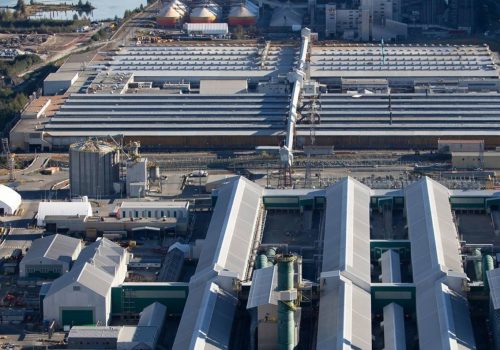
Industrial decarbonisation
Industry, which includes mining, manufacturing and construction, is responsible for almost half of Australia’s emissions when the use of electricity is factored in.
Electricity use or direct fuel combustion is responsible for half of all industry emissions. When electricity use is excluded, this number drops to around 34%.
The process of creating cement, iron or steel from raw materials is extremely varied and energy intensive. This makes industry one of the toughest sectors to decarbonise with a variety of solutions. Renewable electricity and full electrification offers the possibility of achieving zero emissions for industry sectors such as aluminium, iron and steel manufacturing, and other light manufacturing. Other industries such as thermal coal, oil and gas extraction are at odds with a safe climate future, and will need to be phased out as a matter of urgency.
At the same time, new opportunities are arising for the mining industry, and other industries, in Australia. Skyrocketing demand for batteries, electric vehicles, and renewable energy technologies in the global race to net zero will drive increased demand for Australia’s critical minerals – including lithium, cobalt, and rare earths.

Ensure major polluters
do their fair share
The Safeguard Mechanism is intended to manage Australia’s biggest industry polluters, who are responsible for around a quarter of Australia’s total emissions.
In principle, the mechanism does this by setting a baseline limit on how much carbon pollution can be emitted by a facility in a single year. Policing of this mechanism has been poor since its creation by the former Liberal National government in 2014, and no company has ever been penalised for exceeding their baseline despite one in five fossil fuel companies repeatedly doing so.
A well-designed Safeguard Mechanism can make sure big polluting industry starts doing its fair share in reducing Australia’s emissions. Significant design changes, good will and increased ambition from big industrial polluters are all needed to get emissions down in this sector.
What needs to happen by 2030?
What are the benefits?
Rapidly cutting pollution: Modelling conducted prior to the 2022 federal election showed tightening the Safeguard Mechanism could prevent 213 million tonnes of greenhouse gas emissions this decade. That's about the same as the emissions saved this decade if we shut four coal-fired power stations today
New jobs: The same modelling found that redesigning the Safeguard Mechanism to ensure major polluters do their fair share would create an estimated 1600 new jobs by 2030, with 5 out of 6 of these jobs rurally located
Setting a precedent: A well-operating Safeguard Mechanism will set Australia's largest emitters on a path away from fossil fuels and help future-proof jobs within Australian industry
Case Study
The Kitimat aluminium smelter in British Columbia, Canada, shows how big industry can go clean and green to keep providing jobs and critical materials in a zero emissions future.


